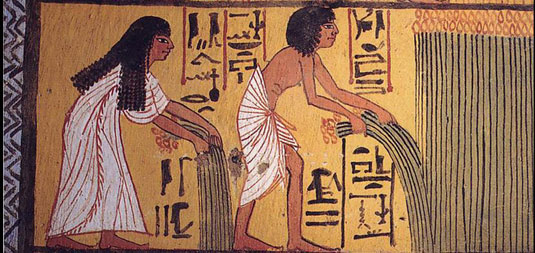What Did Ancient Egyptians Really Eat?

Anonymous Egyptian tomb artist(s) [Public domain], via Wikimedia Commons
(ISNS) -- Did the ancient Egyptians eat like us? If you're a vegetarian, tucking in along the Nile thousands of years ago would have felt just like home.
In fact, eating lots of meat is a recent phenomenon. In ancient cultures vegetarianism was much more common, except in nomadic populations. Most sedentary populations ate fruit and vegetables.
Although previous sources found the ancient Egyptians to be pretty much vegetarians, until this new research it wasn't possible to find out the relative amounts of the different foods they ate. Was their daily bread really daily? Did they binge on eggplants and garlic? Why didn't someone spear a fish?
A French research team figured out that by looking at the carbon atoms in mummies that had lived in Egypt between 3500 B.C. and 600 A.D. you could find out what they ate.
All carbon atoms are taken in by plants from carbon dioxide in the atmosphere by the process of photosynthesis. By eating plants, and the animals that had eaten plants, the carbon ends up in our bodies.
The sixth-lightest element on the periodic table – carbon – exists in nature as two stable isotopes: carbon-12 and carbon-13. Isotopes of the same element behave the same in chemical reactions but have slightly different atomic masses, with the carbon-13 being slightly heavier than the carbon-12. Plants are categorized into two groups. The first group, C3, is most common in plants such as garlic, eggplants, pears, lentils and wheat. The second smaller group, C4, comprises foodstuffs like millet and sorghum.
The common C3 plants take in less of the heavier isotope carbon-13, while the C4 plants take in more. By measuring the ratio of carbon-13 to carbon-12 you can distinguish between these two groups. If you eat a lot of C3 plants, the concentration of carbon-13 isotopes in your body will be lower than if your diet consisted mainly of C4 plants.
The mummies that the French researchers studied were the remains of 45 people that had been shipped to two museums in Lyon, France during the 19th century. "We had an approach that was a little different," explained Alexandra Touzeau, who led the research team at the University of Lyon. "We worked a lot with bones and teeth, while most researchers study hair, collagen and proteins. We also worked on many different periods, with not many individuals for each period, so we could cover a very long time span."
The researchers reported their findings in the Journal of Archaeological Science. They measured carbon-13 to carbon-12 ratios (and also some other isotope ratios) in bone, enamel and hair in these remains, and compared them to similar measurements performed on pigs that had received controlled diets consisting of different proportions of C3 and C4 foodstuffs. As pigs have a similar metabolism to humans, their carbon isotope ratios could be compared to what was found in the mummies.
Hair absorbs a higher rate of animal proteins than bone or teeth, and the isotope ratios in hair of the mummies corresponded to that found in hair of modern European vegetarians, confirming that the ancient Egyptians were also mainly vegetarians. As is the case with many modern people, their diet was wheat- and barley-based. A main conclusion of the research was that C4 cereals, like millet and sorghum, were only a minor part of the diet, less than 10 percent.
But there were a few surprises.
"We found that the diet was constant over time; we had expected changes," said Touzeau. This showed that the ancient Egyptians adapted well to the environment while the Nile region became increasingly arid between 3500 B.C. and 600 A.D.
To Kate Spence, an archeologist and specialist in ancient Egypt at the U.K.'s University of Cambridge, this could be expected: "Although the area is very arid, they were cultivating crops along the river just by managing irrigation, which is very effective," she said. When the level of the Nile decreased, farmers just came closer to the river and kept on cultivating in the same way.
The real mystery is the fish. Most people would probably expect the ancient Egyptians living along the Nile to have eaten loads of fish. However, despite considerable cultural evidence, there seems to have been little fish in their diet.
"There is abundant evidence for fishing in Egyptian wall reliefs and models (both spear and net fishing), and fish shows up in offering lists. There is also a lot of archeological evidence for fish consumption from sites such as Gaza and Amama," said Spence, who added that some texts indicated that a few fish species were not consumed due to religious associations. "All this makes it a bit surprising that the isotopes should suggest that fish was not widely consumed."
Alexander Hellemans is a freelance science writer who has written for Science, Nature, Scientific American, and many others.
